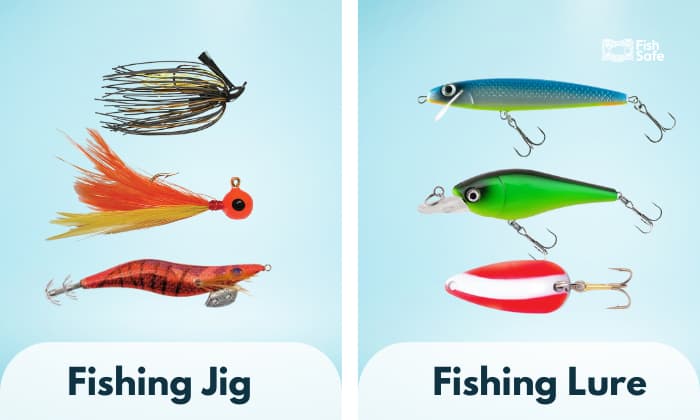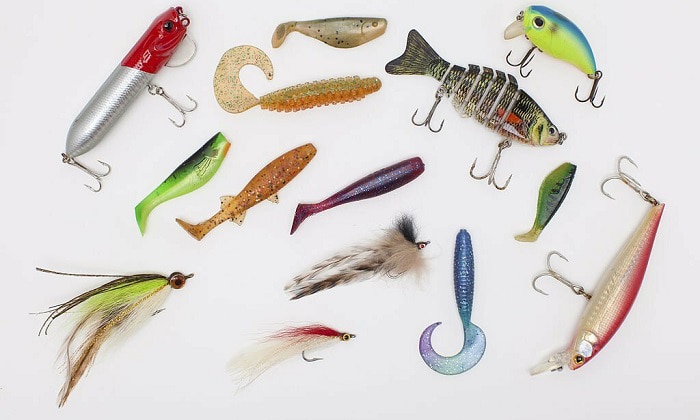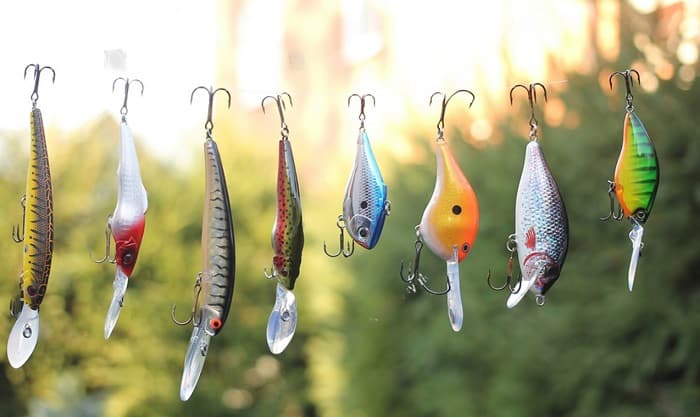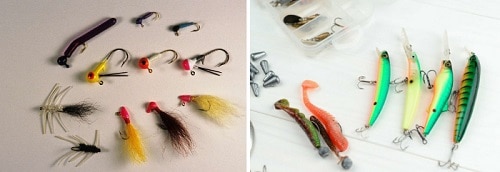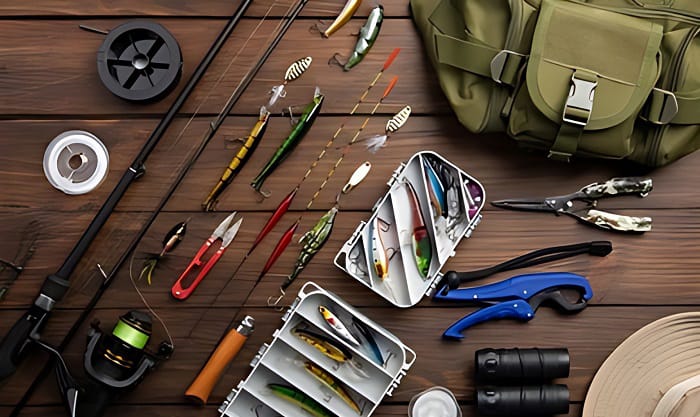In fishing, selecting the right gear can greatly impact the success of your fishing journey. As an angler, you hold in your hand a decision as crucial as any cast—fishing jig or lure.
You might have heard about the never-ending debate of fishing jig vs. lure and wondered about the differences between the two.
Join us as we dive deep into the thrilling world of fishing jigs and lures, unraveling the secrets of plastic lures, plug lure types, and the art of knowing precisely when to use your artificial fishing baits.
Let’s set sail into the heart of fishing intrigue—where jigging meaning meets lure magic, and every cast holds the promise of aquatic wonder.
| Aspects | Fishing Jig | Fishing Lure |
| Type of Fish | Bass, Snapper, Pike, Amberjack, Salmon | Panfish, Trout, largemouth bass, pike, bluegills, crappiers |
| Fishing Technique | Jigging Technique | Horizontal Motion, Trolling |
| Cost | Less Expensive | It can be expensive depending on the materials |
| Material | Metal, Feathers, and other synthetic materials | Plastics |
Page Contents
What is a Fishing Jig?
Fishing jigs are typically weighted hooks wherein the lead sinker is inside and adorned with various materials such as metal, feathers, fur, or synthetic materials. These lures are great for vertical jigging and ideal for targeting bottom-dwelling species.
Jigging is a technique that uses mostly vertical and jerky motions to catch the attention of target fish. This fishing technique is suitable for different types of species and deeper waters.
What is a Fishing Lure?
Lures, on the other hand, comprise different designs that mimic the appearance and movement of prey. Plug lure types, for instance, emulate injured fish on the water’s surface, making them effective for topwater fishing. They are versatile and can imitate anything from small fish to insects.
Here are some fishing lure names that you can choose from:
- Plugs
- Spoons
- Spinnerbait
- Soft Plastics
- Flies
Similarities & Differences
Fishing jigs and lures are indispensable tools that must be present in your fishing tackle box. Each offers a unique approach to enticing fish, and understanding their similarities and differences is essential for choosing the right one for your fishing expedition.
1. Similarities
- Attracting Fish: Both fishing jigs and lures are designed to attract fish. They mimic the appearance, movement, and behavior of prey, triggering a predatory response from the target fish.
- Versatility: Jigs and lures come in various shapes, sizes, and designs, providing anglers with versatile options to adapt to different fishing scenarios and target species.
- Artificial Bait: Jigs and lures are considered artificial baits, making them a preferred choice for anglers who prefer not to use live bait. This can be advantageous in terms of convenience and ethical considerations.
2. Differences
- Fishing Technique
Jigs are typically used with a vertical jigging technique. Anglers lower them to the desired depth and then jerk or bounce them up and down to imitate prey. This makes them particularly effective for bottom-dwelling species.
On the other hand, lures are designed for casting lines in horizontal motion and trolling and are cast out and retrieved to mimic the swimming action of prey. They are versatile and can be used effectively in various retrieval styles, including topwater, subsurface, and deepwater fishing.
- Design
Fishing jigs are typically made of metal, plastic, or wood on one end and a hook on the opposite. The lead sinker adds volume to the jig, allowing it to descend deeper into the water vertically.
Moreover, fishing lures are crafted considering the prey’s shapes, colors, and patterns. Beyond simulating the appearance of typical fish prey, these lures can mimic various aquatic creatures or objects like worms or insects found in the water.
- Cost
Fishing jigs are generally less expensive than fishing lures, as they have a simpler design and are often made from less expensive materials. Fishing jigs typically range from $2 to $25 on Amazon, depending on the size, brand, and material.
However, lures can vary widely in price, depending on the materials used and the complexity of the design. The cost of lures can vary significantly based on factors such as complexity, brand reputation, and specific lure type.
Some simple lures, such as spinners and spoons, can be purchased for as little as $3, while more complex lures, such as crankbaits and jerkbaits, can cost up to $20 or more.
It is important to note that the price of fishing lures and jigs does not necessarily correlate with their effectiveness. Choosing the right jig or lure for the type of fish you target and the fishing conditions is more important.
3. Pros and Cons
1. Fishing Jigs
- Customizable: If you decide on a different combination of jig heads and tails, a straightforward process of switching. This adaptability enhances your ability to cater to the preferences of the fish you’re catching.
- Affordability: Fishing jigs are generally more affordable than many lure options. This cost-effectiveness ensures you can experiment, try different combinations, and refine your jigging techniques without breaking the bank.
- Versatility in Depths: Anglers can easily adjust the depth at which they fish by varying the jig’s weight, allowing for effective fishing in different spots.
- Limited to Specific Fishing Techniques: Jigs are primarily designed for vertical jigging, which limits their use to specific fishing techniques. Jigging fishing may not be as versatile as lures regarding retrieval styles.
2. Fishing Lures
- Suitable for Multiple Species: Lures are versatile and can target different fish species, from predatory gamefish to panfish.
- Fishing without Live Bait: Using artificial fishing bait helps maintain healthy populations of bait species, preventing overharvesting and contributing to the long-term ecological balance of aquatic ecosystems.
- Enhances Fish Survival in Catch and Release: This reduction in deep hooking incidents translates to lower mortality rates among the fish population, promoting responsible angling and conservation efforts.
- Cost: High-quality lures, such as plug lure types, can be relatively expensive compared to other fishing gear
- Location Dependency: Lures perform optimally when cast in areas where fish are already abundant. This means that anglers using lures might experience longer waits for a bite and may need to relocate to various spots in search of active fish.
Fishing Lure vs Jig: Which is Better?
Choosing between fishing jigs and lures hinges on several key considerations, allowing you to tailor your decision to your angling preferences and goals.
Here are some essential factors to remember when to use certain fishing lures and jigs:
Choose to Fish with Jig If
- You want a bigger catch like bass and pike. Using bait jigging, you can catch a snapper, amberjack, and grouper in saltwater.
- You want a budget-friendly option.
- You are opting to fish in deeper waters.
- You enjoy vertical jigging and bottom fishing.
Choose to Fish with Lures If
- You are looking for smaller fishes like panfish and trout.
- Your budget allows for some flexibility.
- You want an adaptable choice for different water depths.
- You want to be more versatile in your retrieval style.
Conclusion
There’s no clear winner in the eternal fishing debate of fishing jig vs. lure. Both have their unique strengths and weaknesses. The right choice ultimately depends on your fishing goals, preferences, and the specific conditions of your fishing trip.
By understanding the definition and difference between lure and bait jigging and considering the factors mentioned, you’ll be better equipped to make an informed decision that maximizes your chances of landing the perfect catch.
So, whether you choose to jig or lure, may your fishing adventures be filled with excitement and success.

Hi, I’m Thomas Kirk. As someone who loves fishing, I am here to offer everyone help on all aspects of angling, whether it’s preparing live bait or determining when to crank in a fish. As you go through the guides here, feel free to let us know your thoughts and any topics you want to learn more about.


